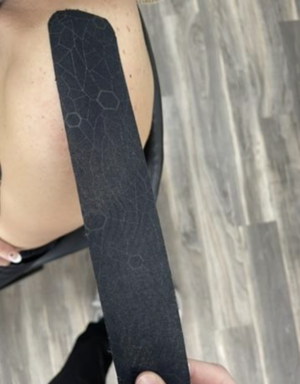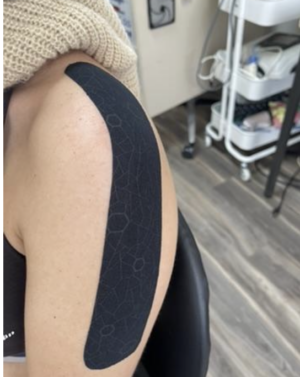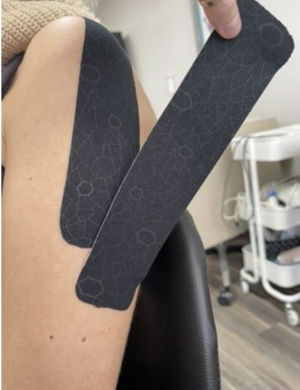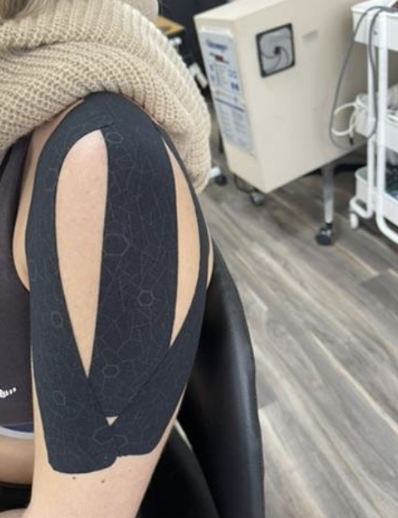How to use Kinesiology Taping for Shoulder Subluxation
Filed under Treatments
How to us Kinesiology Tape for Shoulder Subluxation
By: Tayler Roost
What is shoulder subluxation?
Shoulder subluxation is a dislocation of the glenohumeral joint. This can be classified as traumatic, non-traumatic, or neurological. A traumatic shoulder subluxation can be caused by contact sports or repetitive shoulder movements. A non-traumatic shoulder subluxation can be caused indirectly by another injury such as a rotator cuff tear. A neurological shoulder subluxation can stem from diagnoses such as a stroke, spinal cord injury, or brachial plexus injury. Whatever the category of subluxation is, it affects the person’s ability to functionally use their arms, especially during lifting, flexing, and abducting their affected shoulder.
How to know when someone has shoulder subluxation?
The person will usually present with pain in the shoulder, loss of range of movement, and a palpable gap between the humeral head and the acromion. The subluxation is typically measured in finger width. Special tests can be completed as well to identify if there is a subluxation such as the load and shift test, apprehension test, and relocation test.
How to use kinesiology tape for subluxation support:
- Cut 3 strips of kinesiology tape into 6in-8in pieces with rounded corners

- Anchor at the top of the deltoid


- Add a second piece, anchoring at mid-arm, stretching to approximately 30-50%, and attaching at the upper trapezius with shoulder approximated
- Add a third piece following the same steps as above anchoring at mid-arm, stretching to approximately 30-50%, and attaching at AC joint area with shoulder approximated


- Rub to adhere and they should be good to go! Ensure skin integrity and patient satisfaction after application.
Reference:
Chang, K., & Vitoonpong, T. (2023). Shoulder subluxation – statpearls – NCBI bookshelf.
National Library of Medicine. https://www.ncbi.nlm.nih.gov/books/NBK507847/
1 Comments
Leave a Comment
More To Read
CMC Arthritis Orthosis in the Hand: Mechanics and Purpose
One of the most common diagnoses we see in hand therapy is osteoarthritis of the 1st carpo-metacarpal joint where the metacarpal articulates with the trapezium. Also known as basal joint arthritis (CMC arthritis), this causes pain, joint deformity, loss of strength and loss of function. Patients come to us looking for relief of symptoms and…
Read MoreHand Therapy: Does Dry Needling work to Treat Trigger Finger
By: Taylor Volentine Reference: Azizian, M., Bagheri, H., Olyaei, G., Shadmeher, A., Okhovatpour, M. A., Dehghan, P., Jalaei, S., Sarafraz, H. (2019). Effects of dry needling on tendon-pulley architecture, pain and hand function in patients with trigger finger: a randomized controlled trial study. The Journal of Physical Therapy Science, 31. 295-298. doi:10.1589/jpts.31.295 Photo retrieved from…
Read MoreAssessing and Improving Grip with the Squegg
Assessing and Improving Grip with the Squegg By: Megan Prather “Grip training is made fun” In hand therapy we are always looking for engaging new interventions to use with patients. The Squegg is a dynamic grip-training tool that can be used with clients both to assess grip strength and to improve strength across sessions. This…
Read MoreSign-up to Get Updates Straight to Your Inbox!
Sign up with us and we will send you regular blog posts on everything hand therapy, notices every time we upload new videos and tutorials, along with handout, protocols, and other useful information.




This article on kinesiology taping for shoulder subluxation is very informative. I appreciate the detailed instructions and emphasis on proper assessment. The examples and videos provided make it easy to understand and implement. Thank you, Hand Therapy Academy, for this valuable resource!